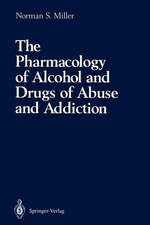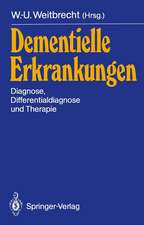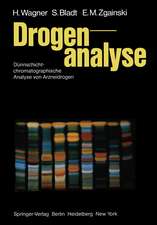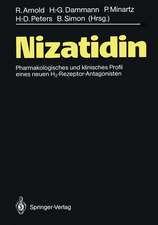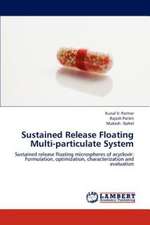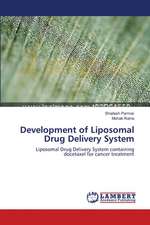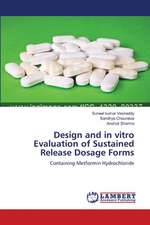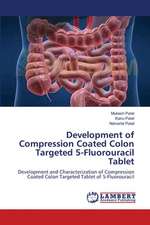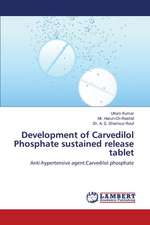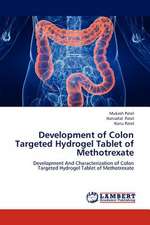Antipsychotics: Handbook of Experimental Pharmacology, cartea 120
Editat de John G. Csernanskyen Limba Engleză Paperback – 16 sep 2011
Din seria Handbook of Experimental Pharmacology
- 5%
 Preț: 3517.78 lei
Preț: 3517.78 lei - 5%
 Preț: 1425.97 lei
Preț: 1425.97 lei - 5%
 Preț: 1435.28 lei
Preț: 1435.28 lei - 5%
 Preț: 1430.52 lei
Preț: 1430.52 lei - 5%
 Preț: 1930.69 lei
Preț: 1930.69 lei - 5%
 Preț: 1922.47 lei
Preț: 1922.47 lei - 5%
 Preț: 1937.46 lei
Preț: 1937.46 lei - 5%
 Preț: 2117.58 lei
Preț: 2117.58 lei - 5%
 Preț: 2119.96 lei
Preț: 2119.96 lei - 5%
 Preț: 2117.38 lei
Preț: 2117.38 lei - 5%
 Preț: 1088.15 lei
Preț: 1088.15 lei - 5%
 Preț: 1098.27 lei
Preț: 1098.27 lei - 5%
 Preț: 1420.29 lei
Preț: 1420.29 lei - 5%
 Preț: 1104.84 lei
Preț: 1104.84 lei - 5%
 Preț: 1104.84 lei
Preț: 1104.84 lei - 5%
 Preț: 1108.14 lei
Preț: 1108.14 lei - 5%
 Preț: 1106.69 lei
Preț: 1106.69 lei - 5%
 Preț: 1105.77 lei
Preț: 1105.77 lei - 5%
 Preț: 1174.35 lei
Preț: 1174.35 lei - 5%
 Preț: 408.48 lei
Preț: 408.48 lei - 5%
 Preț: 409.63 lei
Preț: 409.63 lei - 5%
 Preț: 539.89 lei
Preț: 539.89 lei - 5%
 Preț: 720.47 lei
Preț: 720.47 lei - 5%
 Preț: 733.09 lei
Preț: 733.09 lei - 5%
 Preț: 731.27 lei
Preț: 731.27 lei - 5%
 Preț: 746.43 lei
Preț: 746.43 lei - 5%
 Preț: 747.72 lei
Preț: 747.72 lei - 5%
 Preț: 725.24 lei
Preț: 725.24 lei - 5%
 Preț: 742.80 lei
Preț: 742.80 lei - 5%
 Preț: 393.23 lei
Preț: 393.23 lei - 5%
 Preț: 735.66 lei
Preț: 735.66 lei - 5%
 Preț: 728.33 lei
Preț: 728.33 lei - 5%
 Preț: 389.52 lei
Preț: 389.52 lei - 5%
 Preț: 730.71 lei
Preț: 730.71 lei - 5%
 Preț: 740.58 lei
Preț: 740.58 lei - 5%
 Preț: 730.19 lei
Preț: 730.19 lei - 5%
 Preț: 723.42 lei
Preț: 723.42 lei - 5%
 Preț: 731.27 lei
Preț: 731.27 lei - 5%
 Preț: 726.68 lei
Preț: 726.68 lei - 5%
 Preț: 3516.49 lei
Preț: 3516.49 lei - 5%
 Preț: 729.26 lei
Preț: 729.26 lei - 5%
 Preț: 737.11 lei
Preț: 737.11 lei - 5%
 Preț: 738.78 lei
Preț: 738.78 lei - 5%
 Preț: 909.94 lei
Preț: 909.94 lei - 5%
 Preț: 720.10 lei
Preț: 720.10 lei - 5%
 Preț: 734.74 lei
Preț: 734.74 lei - 5%
 Preț: 727.80 lei
Preț: 727.80 lei - 5%
 Preț: 3513.38 lei
Preț: 3513.38 lei
Preț: 730.92 lei
Preț vechi: 769.39 lei
-5% Nou
Puncte Express: 1096
Preț estimativ în valută:
139.90€ • 145.50$ • 117.23£
139.90€ • 145.50$ • 117.23£
Carte tipărită la comandă
Livrare economică 13-27 martie
Preluare comenzi: 021 569.72.76
Specificații
ISBN-13: 9783642646539
ISBN-10: 3642646530
Pagini: 572
Ilustrații: XXV, 539 p. 2 illus. in color.
Dimensiuni: 155 x 235 x 30 mm
Greutate: 0.79 kg
Ediția:Softcover reprint of the original 1st ed. 1996
Editura: Springer Berlin, Heidelberg
Colecția Springer
Seria Handbook of Experimental Pharmacology
Locul publicării:Berlin, Heidelberg, Germany
ISBN-10: 3642646530
Pagini: 572
Ilustrații: XXV, 539 p. 2 illus. in color.
Dimensiuni: 155 x 235 x 30 mm
Greutate: 0.79 kg
Ediția:Softcover reprint of the original 1st ed. 1996
Editura: Springer Berlin, Heidelberg
Colecția Springer
Seria Handbook of Experimental Pharmacology
Locul publicării:Berlin, Heidelberg, Germany
Public țintă
Professional/practitionerCuprins
1 Classification Schemes for Antipsychotic Drugs.- A. Introduction.- I. Historical Perspective.- B. Classification by Patterns of Efficacy and Neurological Side Effects.- C. Classification by Chemical Structure.- I. Phenothiazines.- II. Thioxanthenes.- III. Butyrophenones.- IV. Diphenylbutylpiperidines.- V. Indoles.- VI. Benzamides.- VII. Dibenzapines.- VIII. Others.- D. Classification by Potency and Nonneurologic Side-Effect Profile.- E. Classification by Pharmacological Mechanism.- I. Selective Dopamine Receptor D2 Antagonists.- II. Combined D2/D3 Antagonists.- III. Combined D2/D1 Antagonists.- IV. Combined 5-HT2-D2 Antagonists.- F. Future Classification Schemes.- I. Selective Serotonin Receptor Antagonists.- II. Partial D2 Agonists.- III. Sigma Site Antagonists and Excitatory Amino Acid Agonists.- IV. GABA-Mimetics and Partial Benzodiazepine Agonists.- G. Conclusions.- References.- 2 Molecular Models and Structure-Activity Relationships.- A. Introduction.- B. Structure-Activity Relationships of Antipsychotic Drugs.- C. Neurotransmitter Receptor Models.- D. Molecular Modelling of Drug-Receptor Interactions.- I. Electrostatic Fields Around Drug and Receptor Molecules.- II. Molecular Dynamics of Drug-Receptor Interactions.- E. Conclusions.- References.- 3 Interaction of Antipsychotic Drugs with Dopamine Receptor Subtypes.- A. Introduction.- B. Molecular Biology of Dopamine Receptor Subtypes.- I. General Structural Features of Dopamine Receptors.- II. The D1 Family of Dopamine Receptors.- 1. The Dopamine D1 Receptor.- 2. The Dopamine D5 Receptor.- III. The D2 Family of Dopamine Receptors.- 1. The Dopamine D2 Receptor.- 2. The Dopamine D3 Receptor.- 3. The Dopamine D4 Receptor.- C. Pharmacology of Neuroleptics at Recombinant Dopamine Receptors.- I. Traditional Neuroleptics and Related Compounds.- II. Clozapine and the Atypical Neuroleptics.- III. New Antipsychotics.- 1. Olanzapine: A Second-Generation Clozapine-Like Compound.- 2. Remoxipride: A D2 Receptor-Selective Substituted Benzamide.- 3. Risperidone: A D2/5-HT2 Receptor Antagonist.- D. Future Outlook and Hopes for Subtype-Specific Drugs.- References.- 4 Atypical Antipsychotic Drugs: Clinical and Preclinical Studies.- A. Introduction.- B. Glutamate.- I. Glutamate Receptors.- II. Glutamate Hypothesis of Schizophrenia.- III. Glutamatergic Drugs.- 1. Glycine and Milacemide.- 2. Umespirone.- 3. Others.- C. ?-Aminobutyric Acid (GABA).- I. GABA Receptors.- II. GABA Hypothesis of Schizophrenia and Clinical Studies of GABA-ergic Drugs.- D. Acetylcholine.- I. Acetylcholine Receptors.- II. Muscarinic Hyperactivity in Schizophrenia? •.- E. Norepinephrine.- I. ?1-Adrenergic Receptor Involvement in Atypical Antipsychotic Drug Actions.- F. Cholecystokinin (CCK).- I. CCK-ergic Drugs.- 1. LY262691.- 2. Caerulin.- 3. Others.- G. Neurotensin.- I. Neurotensin and Schizophrenia.- II. Effects of Atypical Antipsychotic Drugs on Neurotensin Systems.- H. Sigma Receptors.- I. Sigma Receptors.- II. Preclinical Studies.- III. Specific Agents.- I. Opioids.- J. Serotonin.- I. 5-HT Receptors and Schizophrenia.- II. Selective 5-HT2A/2C Antagonists.- 1. Ritanserin.- 2. ICI169369 and MDL100907.- 3. Mianserin.- III. Mixed 5-HT2/D2 Antagonists.- 1. Clozapine.- 2. Risperidone.- 3. Melperone.- 4. Olanzapine.- 5. Amperozide.- 6. Fluperlapine.- 7. Tiosperone.- 8. Zotepine.- 9. Others.- IV. 5-HT3 Antagonists.- V. Nonselective 5-HT Receptor Antagonists.- VI. 5-HT Reuptake Inhibitors.- K. Conclusions.- References.- 5 Sites and Mechanisms of Action of Antipsychotic Drugs as Revealed by Immediate-Early Gene Expression.-A. Introduction.- B. Immediate-Early Gene Expression as a Method to Assess the Sites and Mechanisms of Action of Antipsychotic Drugs (APDs).- C. Effects of APDs on Immediate-Early Gene Induction in the Striatal Complex.- I. Effects of APDs on Regionally Specific Striatal Immediate-Early Gene Expression.- 1. Dorsal Striatum.- 2. Ventral Striatum.- II. Striatal Immediate-Early Gene Induction: Fos, Fos-Related Antigens, and Others.- 1. Fos Versus Fras.- 2. Other Immediate-Early Genes.- III. Mechanisms of Antipsychotic Drug-Elicited Striatal Fos Expression.- 1. Dopamine Receptors and APD-Elicited Increases in Striatal Fos.- a) D2 Dopamine Receptors.- b) D1 Dopamine Receptors.- c) Concurrent D2/D1 Receptor Occupancy and Striatal Fos Expression.- 2. Involvement of Excitatory Amino Acid Receptors in Neuroleptic-Elicited Striatal Fos Expression.- 3. Cholinergic and Adenosine Receptors.- a) Muscarinic Cholinergic Receptors.- b) Adenosine A2 Receptors.- IV. Acute Versus Chronic Effects of APDs on Striatal Fos Expression.- V. What Is the Transcriptional Target of APD-Elicited Striatal Fos Expression?.- 1. Neurotensin.- 2. Enkephalin.- 3. Glutamic Acid Decarboxylase.- D. Preferential Induction of Fos in the Prefrontal Cortex (PFC) by Clozapine.- I. Regional Effects of APDs on Fos Expression in the PFC.- 1. Effects of APDs on Fos Expression in the Medial PFC.- 2. Correlations Between PFC Expression and Clinical Status.- II. Receptor Mechanisms of Clozapine-Elicited Increase in PFC Fos Expression.- 1. D1 and D2 Dopamine (DA) Receptors and Clozapine-Elicited Fos Expression.- 2. Nondopaminergic Receptors and the PFC Fos Response to Clozapine.- 3. Mechanisms of Clozapine-Elicited Increases in PFC Fos Expression.- a) Possible Role of a Novel DA Receptor in Mediating Clozapine-Elicited Effects.- b) Targeting of Multiple Receptors.- c) Transsynaptic Events as a Possible Determinant of Clozapine-Induced Changes.- III. Transcriptional Targets of Clozapine’s Actions in the PFC.- E. Effects of APDs on Immediate-Early Gene Expression in Other CNS Sites.- I. Thalamic Paraventricular Nucleus.- II. Lateral Septal Nucleus.- III. Other CNS Regions.- F. Conclusions.- I. Methodological Issues.- II. Validity of Fos Expression as a Model of the Actions of APDs.- III. Future Directions.- References.- 6 Basic Neurophysiology of Antipsychotic Drug Action.- A. Introduction.- B. The Dopamine Hypothesis of Schizophrenia.- I. Antipsychotic Drugs as D2 Blockers.- II. Shortcomings of the Dopamine Hypothesis.- C. Acute Physiology of Antipsychotic Drug Action.- I. Dopamine Cell Identification and Physiology.- II. Acute Actions of Antipsychotic Drugs on Dopamine Cell Physiology.- 1. Acute Antipsychotic Drugs Increase Firing Rate.- 2. Acute Antipsychotic Drug Administration Increases Dopamine Cell Burst Firing.- 3. Acute Antipsychotic Drug Treatment Increase the Number of Dopamine Cells Firing Spontaneously.- D. Physiology of Chronic Antipsychotic Drug Treatment.- I. Tolerance to Antipsychotic Drug Action.- II. Chronic Treatment with Antipsychotic Drugs and Dopamine Cell Depolarization Block.- III. Analysis of Mechanisms Contributing to Depolarization Block: Compensatory Systems Involved in the Recovery of Function After Dopamine Lesions.- E. Dual Mode of Dopamine Release: Tonic Versus Phasic.- F. Antipsychotic Drug Treatment and Electrotonic Transmission Within the Basal Ganglia.- I. Dopaminergic Control of Electrotonic Coupling in the Striatum.- II. Effects of Subchronic Treatment with Haloperidol or Clozapine on Striatal Cell Dye Coupling Observed In Vitro.- III. Effects ofSubchronic Treatment with Haloperidol or Clozapine on Striatal Cell Dye Coupling Observed In Vivo.- G. Conclusions.- References.- 7 Tolerance and Sensitization to the Effects of Antipsychotic Drugson Dopamine Transmission.- A. Introduction.- B. Effects of Single Administration on Dopamine and Related Behaviors.- C. Effects of Repeated Administration and the Induction of Sensitization and Tolerance.- I. Tolerance.- II. Sensitization.- D. Atypical Antipsychotic Drugs.- E. Conclusions.- References.- 8 The Behavioural Pharmacology of Typical and Atypical Antipsychotic Drugs.- A. Introduction.- B. Typical and Atypical Antipsychotic Drugs.- I. Concepts and Nomenclature.- II. Atypical Antipsychotic Drugs.- III. Behavioural Testing Procedures for Typical and Atypical Antipsychotic Drugs.- C. Basic Actions of Antipsychotic Drugs and Their Behavioural Effects.- D. Effects on Motor Function.- I. Spontaneous Locomotor Activity.- II. Catalepsy and the Paw Test.- E. Effects of Antipsychotic Drugs on Behavioural Effects Elicited by DA Receptor Agonists or Glutamate Antagonists.- I. d-Amphetamine (Methylphenidate)-Induced Behavioural Effects.- II. Apomorphine-Induced Behavioural Effects.- III. Phencyclidine-Induced Behavioural Effects.- F. Action on Conditioned Avoidance.- G. Animal Models of Psychosis and Antipsychotic Drugs.- H. Conclusions.- References.- 9 Antipsychotic Drug Action After Lesions to the Hippocampus or Frontal Cortex.- A. Introduction.- B. Mechanisms of Antipsychotic Drug Action.- I. Dopaminergic Mechanisms.- II. Glutamatergic Mechanisms.- C. Neuropathology and Antipsychotic Drug Action.- D. Effect of Hippocampal Neuropathology on Mechanisms of Antipsychotic Drug Action.- I. Anatomy.- II. Consequences for Glutamatergic Mechanisms of Antipsychotic Drug Action.- III. Consequences for Dopaminergic Mechanisms of Antipsychotic Drug Action.- 1. Dopamine Receptors.- 2. Dopamine Turnover and Release.- 3. Dopamine-Mediated Behaviors.- IV. Summary.- E. Effect of Frontal Cortical Neuropathology on Mechanisms of Antipsychotic Drug Action.- I. Anatomy.- II. Consequences for Glutamatergic Mechanisms of Antipsychotic Drug Action.- III. Consequences for Dopaminergic Mechanisms of Antipsychotic Drug Action.- 1. Dopamine Receptors.- 2. Dopamine Turnover and Release.- 3. Dopamine-Mediated Behaviors.- IV. Summary.- F. Conclusions.- References.- 10 An Animal Model of Sensorimotor Gating Deficits in SchizophreniaPredicts Antipsychotic Drug Action.- A. Introduction.- I. Face Validity: Are the Eliciting Stimuli and Response Patterns of Prepulse Inhibition (PPI) Similar Across Species?.- II. Predictive Validity: Can This Model Be Used as a Sensitive and Specific Screen of Antipsychotic Potency?.- III. Construct Validity: Is This Model Consistent with Existing Constructs of Schizophrenia?.- 1. Construct Validity in a Neurochemical Domain: Mesolimbic Hyperdopaminergia.- 2. Construct Validity in a Neuroanatomical Domain: PPI After Manipulations of Limbic Corticostriatopallidopontine Circuitry.- a) The Hippocampus.- b) The Ventral Striatum.- c) The Ventral Pallidum and Pontine Reticular Formation.- 3. Construct Validity in a Neurodevelopmental Domain: PPI After Isolation Rearing or Neonatal Brain Lesions.- B. Discussion.- I. Model Limitations.- II. Model Strengths.- C. Conclusions.- References.- 11 Patterns of Clinical Efficacy for Antipsychotic Drugs.- A. Introduction.- B. Rating Scales Used to Measure Neuroleptic Effect.- I. Brief Psychiatric Rating Scale.- II. Clinical Global Impression.- III. Global Assessment Scale.- IV. Negative Symptoms and Rating Scales.- 1. Methodologic Problems in the Measurement of Negative Symptoms.- 2. Rating Scales Used to Measure Negative Symptoms and the Deficit Syndrome.- a) Positive and Negative Syndrome Scale.- b) Scale for the Assessment of Negative Symptoms.- c) Schedule for the Deficit Syndrome.- d) Quality of Life Scale.- V. Rating Scales and Phenomenology.- C. Efficacy of Neuroleptics in Schizophrenia.- I. Efficacy in the Treatment of Schizophrenic Exacerbation.- 1. Introduction of Chlorpromazine.- 2. Treatment of Psychosis.- 3. Treatment of Negative Symptoms.- 4. Neuroleptic Dose and Efficacy.- II. Efficacy of Maintenance Neuroleptic Treatment.- 1. Relapse Prevention.- 2. Neuroleptic Dose and Efficacy.- III. Neuroleptics with Special Profiles of Efficacy.- References.- 12 Efficacy of Novel Antipsychotic Drugs in Treatment-Refractory Schizophrenia.- A. Introduction.- B. The Concept of Atypicality.- C. Atypical Antipsychotic Drugs.- I. Clozapine.- 1. Effect on Psychopathology.- a) Effect on Positive Symptoms.- b) Effect on Negative Symptoms.- c) Effect on Disorganization Symptoms.- d) Effect on Cognitive Function.- e) Effect on Mood Symptoms.- f) Effect on Quality of Life.- 2. Duration of Clozapine Trials.- 3. Clozapine Dosage and Administration.- 4. Relationship Between Clinical Efficacy and Plasma Concentrations of Clozapine.- 5. Predictors of Response to Clozapine.- 6. Nonresponders to Clozapine Therapy and Augmentation Strategies.- 7. Dropouts and Withdrawal from Clozapine.- 8. Cost-Effectiveness.- II. Risperidone.- 1. Effect on Psychopathology.- 2. Risperidone Dosage and Administration.- III. Melperone.- IV. Remoxipride.- V. Amperozide.- VI. Others.- D. Conclusions.- References.- 13 Antipsychotic-Induced Side Effects Related to Receptor Affinity.- A. Introduction.- B. Predictableand Unpredictable Side Effects.- C. Classification of Antipsychotic Drugs.- D. Side Effects in Relation to Receptor Affinities.- I. Side Effects Related to Dopamine D2 Receptor Binding.- 1. Psychological Side Effects.- 2. Acute Extrapyramidal Side Effects (EPS).- 3. Tardive EPS.- 4. Hormonal Side Effects.- II. Side Effects Related to Dopamine Receptor Blockade.- III. Side Effects Related to Binding to Receptors Other Than Dopamine Receptors.- IV. Side Effects with No Certain Relation to Receptor Binding.- 1. Neuroleptic Malignant Syndrome.- 2. Agranulocytosis.- E. Older Antipsychotics with Typical and Atypical EPS Profiles.- F. Newer Antipsychotics with Typical and Atypical EPS Profiles.- I. Dopamine-Selective Antipsychotics.- 1. Sulpiride.- 2. Other Substituted Benzamides.- 3. D1 and Combined D1/D2 Dopamine Receptor Antagonists.- II. Newer Antipsychotics with Dopamine-Serotonin-Norepinephrine Antagonism.- 1. Risperidone.- 2. Ziprasidone.- 3. Sertindole.- III. Multiple Receptor Antagonists.- 1. Clozapine.- 2. Olanzapine.- 3. Seroquel.- 4. Zotepine.- G. Management of Side Effects.- I. Prevention.- II. Early Detection of Side Effects.- III. Treatment of Side Effects.- H. Conclusions.- References.- 14 Biological Predictors of Antipsychotic Treatment Response.- A. Introduction.- B. Biochemical Predictors.- I. Homovanillinic Acid (HVA).- II. Dopamine ?-Hydroxylase (DBH).- III. Serotonin (5-HT).- IV. Norepinephrine(NE).- V. Peptides.- C. Behavioral Response to Psychostimulants.- D. Neuroendocrine Studies.- E. Neuroimaging.- I. Structural Brain Imaging.- II. Functional Brain Imaging.- F. Electrophysiologic Predictors.- I. Galvanic Skin Conductance and Heart Rate.- II. Electroencephalography (EEG).- III. Event-Related Potential (ERP).- IV. Saccadic Eye Movements.- G.Discussion.- H. Conclusions.- References.- 15 Effects of Antipsychotic Drugs on Neuropsychological Measures.- A. Introduction.- B. Biological Underpinnings of Cognitive Deficit in Schizophrenia….- C. Cognitive Impairment in Schizophrenia.- D. Anticholinergics and Cognition.- E. Dopamine and Cognition.- I. Related Evidence for the Role of Dopamine in Cognition.- II. Dopamine Agonists, Prefrontal Function, and Cognition in Schizophrenia.- F. Effects of Antipsychotic Drugs on Cognition in Healthy Nonpsychiatric Samples.- G. Effects of Typical Antipsychotics in Schizophrenic Patient Samples.- I. Methodological Limitations in Examining the Effects of Neuroleptics in Schizophrenia.- 1. Lack of Random Assignments to Groups in Studies Contrasting Groups of Medicated and Unmedicated Patients.- 2. Correlations Between Cognitive Impairments and Neuroleptic Dose or Blood Levels Does Not Equal Causation.- 3. Lack of Attention to Sampling Characteristics of the Patients Studied.- 4. Lack of Studies Comparing Multiple Antipsychotics with Different Neuropharmacologic Profiles.- 5. Use of Relatively Acute Dosage Strategies in Patients Receiving Long-Term Treatment.- 6. Lack of Information Regarding the Details of the Study.- 7. Inconsistent or Inappropriate Neuropsychological Test Selection.- H. The Effects of Standard Antipsychotics in Schizophrenia.- I. Attention/Information-Processing Measures.- II. Effects of Typical Antipsychotics on Memory Functions.- III. Antipsychotic Effects on Motor Tasks.- IV. Hemispheric Asymmetries in Cognitive Performance Patterns.- V. Standardized Neuropsychological Batteries and the Wechsler Scales.- VI. Studies Employing a Combination of Selected Cognitive Measures.- I. Effects of Atypical and Recently Developed Antipsychotics on Cognition.- J.Conclusions.- References.- 16 Antipsychotic Drugs in Children and Adolescents.- A. Introduction.- B. Indications.- I. Autism.- II. Tourette’s Syndrome.- III. Obsessive-Compulsive Disorder.- IV. Mental Retardation.- V. Early-Onset Schizophrenia.- VI. Conduct Disorder and Explosive Rage.- VII. Attention-Deficit Hyperactivity Disorder.- VIII. Bipolar Disorder, Manic Phase.- C. Pharmacology.- I. Pharmacokinetics and Pharmacodynamics.- II. Blood Levels.- D. Mechanism of Action.- E. Therapeutic Use.- F. Use in Pregnancy and Nursing.- G. Side Effects and Toxicity.- I. Sedation, Fatigue, and Deterioration of Behavior.- II. Cognitive Effects.- III. Acute Dystonia.- IV. Tardive Dyskinesia.- V. Neuroleptic-Induced Tics.- VI. Parkinsonism, Catatonia, and the Rabbit Syndrome.- VII. Akathisia.- VIII. Neuroleptic Malignant Syndrome.- IX. Seizure Threshold.- X. Unwanted Cardiac Effects.- XI. Hypotension.- XII. Weight Gain.- XIII. Ocular Complications.- XIV. Unwanted Cutaneous Effects.- XV. Hypothalamic and Pituitary Functions - Adverse Effects on Growth.- XVI. Hepatic Complications.- XVII. Hematologic Complications.- XVIII. Sexual Dysfunction.- XIX. Enuresis.- XX. Nondyskinetic Withdrawal Symptoms.- XXI Overdosage.- H. Conclusions and Future Directions.- References.- 17 Use of Antipsychotic Drugs in the Elderly.- A. Introduction.- B. Indications and Clinical Use of Antipsychotics in Late Life.- I. Nosology of Late-Life Psychoses.- II. Delirium.- III. Dementia.- IV. Schizophrenia.- 1. Early-Onset Schizophrenia in Old Age.- 2. Late-Onset Schizophrenia.- V. Delusional Disorder.- VI. Mood Disorders.- 1. Psychotic (Delusional) Major Depression.- 2. Bipolar Disorder (Mania).- C. Pharmacokinetics.- I. General Changes with Age and Illness.- 1. Absorption.- 2. Distribution.- 3. Metabolism.-4. Excretion.- 5. Need for Individualized Assessment.- D. Pharmacodynamics.- E. Conclusions.- References.



